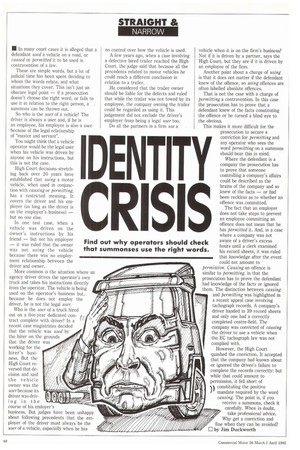• In many court cases it is alleged that a
Page 50

If you've noticed an error in this article please click here to report it so we can fix it.
defendant used a vehicle on a road, or caused or permitted it to be used in contravention of a law.
These are simple words, but a lot of judicial time has been spent deciding to whom the words relate, and what situations they cover. This isn't just an obscure legal point — if a prosecution doesn't choose the right word, or fails to use it in relation to the right person, a summons can be thrown out.
So who is the user of a vehicle? The driver is always a user and, if he is an employee, his employer is also a user because of the legal relationship of "master and servant".
You might think that a vehicle operator would be the legal user when his vehicle was driven by anyone on his instructions, but this is not the case.
High Court decisions stretching back over 20 years have established that using a motor vehicle, when used in conjunction with causing or permitting, has a restricted meaning. It covers the driver and his employer (as long as the driver is on the employer's business) — but no one else.
In one test case, when a vehicle was driven on the owner's instructions by his friend — but not his employer — it was ruled that the owner was not using the vehicle because there was no employment relationship between the
driver and owner.
More common is the situation where an agency driver drives the operator's own truck and takes his instructions directly from the operator. The vehicle is being used on the operator's business but, because he does not employ the driver, he is not the legal user.
Who is the user of a truck hired out on a five-year dedicated conif tract complete with driver? In a 1' recent case magistrates decided that the vehicle was used by the hirer on the grounds that the driver was working for the
hirer's business. But the
High Court reversed that decision and said the vehicle owner was the user because its driver was driving in the course of his emloyer's business. But judges have been unhappy about following precedents that the employer of the driver must always be the user of a vehicle, especially when he has Find that
no control over how the vehicle is used.
A few years ago, when a case involving a defective hired trailer reached the High Court, the judge said that because all the precedents related to motor vehicles he could reach a different conclusion in relation to a trailer.
He considered that the trailer owner should be liable for the defects and ruled that while the trailer was not towed by its employee, the company owning the trailer could be regarded as using it. This judgement did not exclude the driver's employer from being a legal user too.
Do all the partners in a firm use a
vehicle when it is on the firm's business? Not if it is driven by a partner, says the High Court, but they are if it is driven by an employee of the firm.
Another point about a charge of using is that it does not matter if the defendant knew of the offence, so using offences are often labelled absolute offences.
That is not the case with a charge of permitting a contravention. In this case the prosecution has to prove that a defendant knew of the facts constituting the offence or he turned a blind eye to the obvious.
This makes it more difficult for the prosecution to secure a conviction for permitting and any operator who sees the word permitting on a summons should bear this in mind.
Where the defendant is a company the prosecution has to prove that someone controlling a company's affairs could be described as the brains of the company and so knew of the facts — or had been reckless as to whether an offence was committed.
The fact that an employer does not take steps to prevent an employee committing an offence does not mean that he has permitted it. And, in a case where a company was not aware of a driver's excess hours until a clerk examined his record sheets, it was ruled that knowledge after the event could not amount to permission. Causing an offence is similar to permitting, in that the prosecution has to prove the defendant had knowledge of the facts or ignored them. The distinction between causing and permitting was highlighted in a recent appeal case involving tachograph records. A company's driver handed in 39 record sheets and only one had a correctly completed centre-field. The company was convicted of causing the driver to use a vehicle when the EC tachograph law was not complied with.
However, the High Court quashed the conviction. It accepted that the company had known about or ignored the driver's failure to complete the records correctly: but while that could amount to permission, it fell short of yi constituting the positive I mandate required by the word
causing. The point is, if you receive a summons, check it carefully. When in doubt,
take professional advice. Why get a conviction and fine when they can be avoided? by Jim Duckworth




























































































